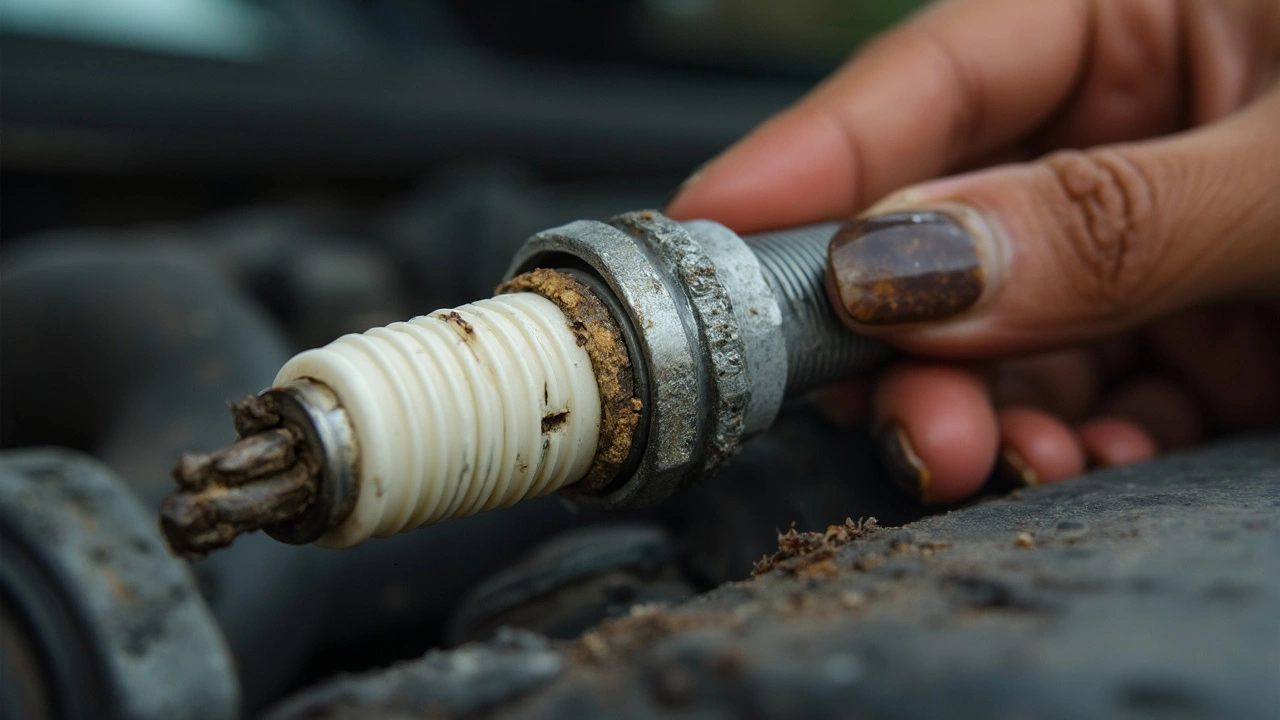Ever felt your car hesitate, shudder, or just run rough? Spark plugs are tiny, but a cracked one can make your whole ride feel broken. Most people think their car’s problems are fuel-related or electrical, but a sneaky cracked plug is behind way more headaches than you’d guess.
Here’s something wild—a single hairline crack in the plug’s ceramic can mess with your engine’s rhythm. You don’t need to be a mechanic to catch the clues either. There are dead giveaways before things get expensive or dangerous.
Let’s break down what to watch out for, how to confirm your suspicion, and why you really shouldn’t ignore those hints your car keeps dropping. Because no one wants to pay for a new catalytic converter just because of a $10 cracked plug.
- Why Cracked Spark Plugs Mess Everything Up
- The Most Obvious Signs Your Plug is Toast
- How to Check Your Spark Plugs at Home
- What Happens If You Keep Driving Anyway
- Simple Tips to Avoid This Problem
Why Cracked Spark Plugs Mess Everything Up
If you’ve ever wondered why such a small part causes big problems, here’s the deal: spark plugs run the show when it comes to igniting fuel inside your engine. A spark plug has to create a strong, clean spark at exactly the right time—over and over, thousands of times a minute. When a plug is cracked, it can’t do its job right.
The most common crack is in the ceramic insulator. That’s the white bit that keeps the spark in check. If it’s cracked, some of the spark leaks out, and suddenly it’s not firing like it should. The engine misses a beat, and you might feel the car stutter or lose power.
But it doesn’t stop there. A weak or misfiring spark can dump extra fuel into the exhaust, wreck your gas mileage, and trigger those annoying check engine lights. Even worse, you risk frying your catalytic converter—a repair that usually costs way more than a set of new plugs.
Check out how fast things can escalate with a cracked plug:
| What Goes Wrong | What You Notice |
|---|---|
| Incomplete combustion | Rough idle, shakes, poor acceleration |
| Unburned fuel hits exhaust | Check engine light, rotten egg smell |
| Damaged catalytic converter | Loss of power, failed emissions test |
| Entire cylinder stops firing | Loud misfires, serious loss of power |
Even small cracks can let moisture sneak in, which makes the spark jump around like a confused rabbit. That can turn a minor hiccup into a breakdown, especially in wet or humid weather. If you’re noticing your car acts up after a rainy night, a cracked spark plug could easily be the reason.
So, that’s why ignoring a cracked plug is more than just annoying—it's a fast track to bigger, pricier issues.
The Most Obvious Signs Your Plug is Toast
If your car’s acting up, cracked spark plugs can make it super obvious—if you know what to watch for. Catching the symptoms early saves you from bigger headaches (and bills) later. Here’s how these tiny villains tip you off:
- Spark plugs causing rough idling: If your car feels like it's about to stall when you stop at a red light, a cracked plug could be the reason. The engine isn’t firing right, so everything shudders.
- Sudden loss of power: Trying to accelerate but your car hesitates or is sluggish? Damaged plugs can trip up combustion and leave you in a bind, especially going uphill.
- Check engine light: Not every warning light is a disaster, but a cracked plug often sparks a misfire code. Grab an OBD-II scanner or swing by an auto store to check.
- Poor fuel mileage: If you're filling up more than usual but your driving habits haven’t changed, a cracked plug could waste gas. Faulty sparks mean your engine burns more fuel to do the same work.
- Weird ticking or popping noises: Sometimes, you’ll actually hear a spark jumping or an electrical snap, kind of like a static zap but louder.
For a quick glance at what’s normal vs. what should worry you, check out this table:
| Symptom | Possible Cause | Danger if Ignored |
|---|---|---|
| Rough idle | Cracked spark plug | Engine stalling, more wear |
| Slow acceleration | Damage to ignition system | Unsafe driving, poor fuel economy |
| Check engine light | Misfire detected | Expensive repairs later |
| Ticking sounds | Electrical arc from cracked plug | Possible catalytic converter damage |
| Bad mileage | Poor combustion due to crack | Wasted money on fuel |
Don’t just brush these off. Even a new car can start acting weird if a plug cracks, so trust your gut (and your ears) if something feels off. You’d be shocked how often this gets overlooked until bigger parts start failing.

How to Check Your Spark Plugs at Home
You don’t need a shop or fancy tools to check if your spark plugs are cracked. Most folks can do it in their own driveway using basics: a spark plug socket, ratchet, and maybe a flashlight. Don’t forget to let the engine cool off first—burned fingers hurt way more than a faulty plug.
- Pop the Hood: Find your spark plugs. On most cars, they’re lined up along the top or side of the engine. If you’ve got a plastic engine cover, you might need to pull it off.
- Remove Plug Wires: Gently twist and pull the spark plug boots or coils off. Don’t yank the wire itself or you might rip it out.
- Unscrew the Plug: Use your spark plug socket and ratchet. Turn it left (counterclockwise). The plug’s threaded metal end and the ceramic insulator will come out together.
- Give It a Good Look: Check the white ceramic for any hairline cracks, chips, or burn marks. Also, peek at the metal part—if it looks melted or super gunky, that’s another red flag.
- Test for Cracks: Hold the plug under a bright light, slowly rotate it, and watch for faint lines, chips, or flakes—especially where the ceramic meets the metal. A cracked plug can be hard to spot, so take your time.
Here’s a quick cheatsheet if you like numbers and want to know how often plugs cause problems:
| Problem | Percent Linked to Spark Plugs |
|---|---|
| Engine misfire | 34% |
| Poor fuel mileage | 17% |
| Car hard to start | 21% |
If you spot a crack, don’t try to glue or tape it—just swap it out. They’re cheap, and a fresh plug saves you a ton of hassle down the road. Even if only one looks bad, check all of them. If one’s cracked, it’s a good bet the others aren’t far behind, especially if they’re all the same age.
What Happens If You Keep Driving Anyway
Ignoring a cracked spark plug doesn’t just mean rough starts or weird noises. The damage can snowball. When a plug has a crack, it can’t deliver a clean, strong spark—so your fuel doesn’t fully burn. That makes your engine stumble, your check engine light start nagging, and your miles per gallon tank faster than a lead-footed driver.
The longer you drive with a compromised plug, the more you risk screwing up other parts. Unburned fuel gets pumped into the exhaust, which can toast your catalytic converter. That’s a big one—replacing a cat can cost $1,000 or more. So your $10 cracked plug can turn into a four-digit repair bill if you just keep pushing.
- Your engine misfires more often, and you’ll notice it, especially at idle or when accelerating.
- Acceleration gets sluggish, and climbing hills feels like punishment for both you and your car.
- Bad fuel economy hits your wallet every trip—it’s not your imagination, you’re burning money.
- Your engine can overheat, since the air/fuel mix isn’t right, adding risk for worse damage.
- Modern cars monitor misfires, so the check engine light almost always comes on after a while.
If you skip fixing your spark plug, here’s the real kicker: the unburned fuel damages your emissions system, and that usually means you won’t pass a smog check. Stuck at a failed inspection or a surprise breakdown, you’ll wish you swapped out that little plug instead of rolling the dice.
| Problem | Potential Cost |
|---|---|
| Cracked Spark Plug | $10–$30 each |
| Damaged Ignition Coil | $70–$300 |
| Catalytic Converter Replacement | $1,000–$2,500 |
| Failed Emissions Test | Varies (repair and re-test fees) |
Long story short: don’t gamble with a spark plug—a small fix now saves you major headaches (and cash) later.

Simple Tips to Avoid This Problem
Here’s the deal—preventing cracked spark plugs is mostly about how you treat them and how often you pay attention. Plenty of drivers go years without issues, but the folks who run into headaches are usually skipping the basics.
- Check your spark plugs regularly. Most manufacturers recommend popping them out and taking a look every 30,000 miles. If your engine is running rough or your mileage drops suddenly, check them sooner.
- Don’t over-tighten when installing spark plugs. People love to crank them down, but too much torque can easily crack the ceramic. Always use a torque wrench and follow your car manual’s spec.
- Buy reputable brands. Generic, dirt cheap plugs might save you a buck now, but they’re infamous for showing cracks early. Spend a little more for a longer-lasting plug.
- Make sure your engine is cool. Pulling spark plugs out of a hot engine risks cracking from rapid cooling. Let things cool off before you swap or inspect.
- Keep your spark plug sockets clean. Grit and debris in the socket act like sandpaper, increasing the chances of trouble during install or removal.
Just to give you an idea what regular care can do, people who stick to their car’s spark plug maintenance schedule run into cracked plugs less than 5% of the time, according to a 2022 auto repair survey.
| Common Cause | Chance of Cracking (%) |
|---|---|
| Skipped Maintenance | 18 |
| Over-tightening | 12 |
| Poor Quality Plugs | 9 |
| Proper Care | Less than 5 |
The main takeaway? Staying on top of spark plug care is simple, costs almost nothing, and will save you a world of pain later. This is one of those boring car chores that really does pay off.




